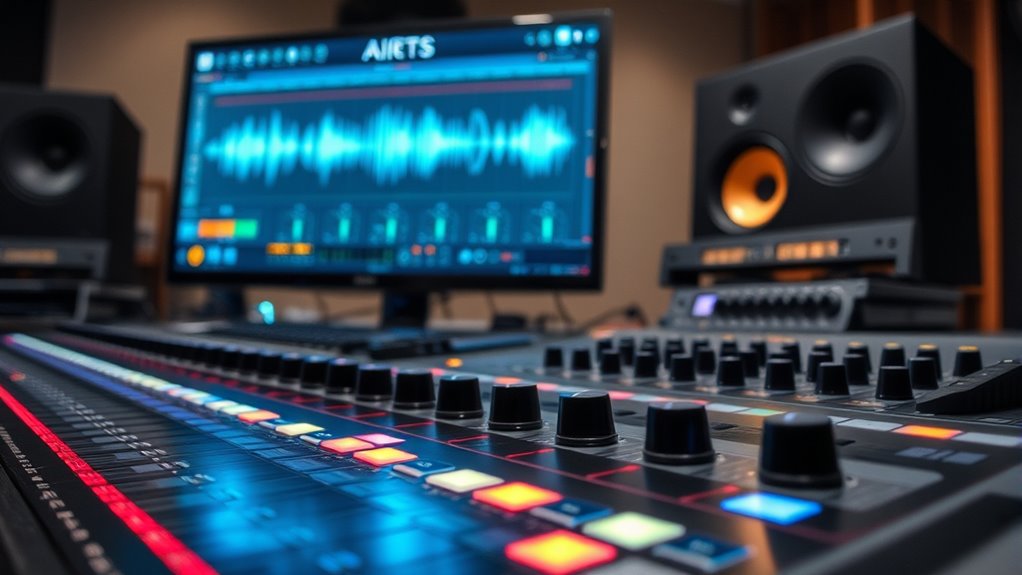Plugin delay compensation automatically adjusts track timing to account for delays caused by effects and plugins that introduce latency. It guarantees your recordings stay synchronized, keeping the project aligned during mixing and playback. You can test it by adding a latency-inducing plugin to a track with a transient signal and checking if it remains in sync. Continuing will reveal more tips on verifying and optimizing PDC for your workflow.
Key Takeaways
- PDC aligns tracks by automatically compensating for plugin-induced processing delays to keep audio synchronized.
- It detects latency from effects like reverb and EQ, adjusting track timing accordingly.
- Testing involves recording a transient signal, adding latency-creating plugins, and verifying alignment during playback.
- Visual indicators or delay meters in DAWs help confirm correct PDC operation and the amount of compensated delay.
- Regular testing ensures that tracks stay in sync, maintaining project integrity and preventing timing issues.

When working with digital audio, plugin delay compensation (PDC) guarantees that all tracks stay synchronized despite the processing delays introduced by certain effects. Without PDC, your recordings can become misaligned, causing timing issues that disrupt the flow of your project. This is especially true when you use effects like reverb, compression, or complex virtual instruments, which can introduce noticeable latency. To keep everything tight, understanding how plugin delay compensation works is essential. PDC automatically adjusts the timing of tracks to compensate for plugin-induced delays, ensuring that your audio remains perfectly aligned during mixing and playback. Recognizing the importance of latency reduction techniques is key here; these methods minimize delays at the source, reducing the need for extensive compensation. Techniques such as optimizing buffer sizes, choosing low-latency plugins, and disabling unnecessary effects during recording are common ways to reduce latency. When testing whether plugin delay compensation is functioning correctly, you can start by recording a simple transient signal, like a transient click or a percussive sound, on one track. Then, add a plugin known to introduce latency—say, a linear-phase equalizer or a high-quality reverb. Play back the track and observe whether the transient stays aligned with the original signal. If it shifts or appears out of sync, your PDC isn’t functioning properly or your latency reduction techniques need adjustment. Many digital audio workstations (DAWs) offer visual indicators or meters to show when PDC is active; some even display the amount of delay compensation being applied. You should verify that the compensation matches the known latency introduced by your plugins. Additionally, you can disable plugin delay compensation temporarily to see if the tracks drift apart, which confirms whether the system is compensating correctly. Regular testing of your setup helps ensure that your workflow remains smooth and your mixes stay precise. Remember, some plugins are “delay-free,” meaning they don’t introduce latency and don’t require PDC, but others do. The key is to understand which effects impact timing and to set your system accordingly. By mastering plugin delay compensation and latency reduction techniques, you maintain the integrity of your recordings and mixes, avoiding timing issues that could otherwise compromise your project’s professionalism. Properly managing audio latency ensures your project stays synchronized from start to finish, saving you time and frustration. Whether you’re recording, mixing, or producing, keeping your tracks synchronized not only saves time but also elevates the overall quality of your work.
Frequently Asked Questions
Can Plugin Delay Compensation Cause Audio Artifacts?
Yes, plugin delay compensation can cause audio artifacts, especially if there’s improper phase alignment or unresolved latency issues. When delay compensation isn’t perfectly aligned, you might hear phasing problems or echoes, affecting your mix’s clarity. To avoid this, test your setup thoroughly, ensuring plugins are correctly delayed and phase-aligned. Adjusting latency settings or manually compensating can help minimize artifacts and maintain audio integrity.
How Do I Disable Plugin Delay Compensation?
Imagine reclaiming your creative control—you can disable plugin delay compensation by adjusting your DAW’s settings. Go to the preferences or options menu, find the section on timing adjustment or latency management, and toggle off plugin delay compensation. Disabling it reduces latency but may cause timing issues. Be sure to test your audio after, ensuring your tracks align perfectly without unwanted delays or artifacts.
Does Plugin Delay Compensation Affect CPU Usage?
Yes, plugin delay compensation can affect your CPU usage by increasing latency impact due to plugin synchronization. When enabled, your system works harder to align plugin processing, which can strain your CPU, especially with multiple plugins active. Disabling it might reduce CPU load, but it can lead to timing issues. You should weigh the benefits of smoother performance against potential synchronization problems when adjusting this setting.
Is Plugin Delay Compensation Necessary for All Plugins?
No, plugin delay compensation isn’t necessary for all plugins. It mainly helps with plugin compatibility and ensuring proper plugin synchronization, especially when using delay-based effects or complex processing. If your plugins are delay-free or your session runs smoothly without sync issues, you can disable it to save CPU resources. However, when working with latency-heavy plugins, enabling delay compensation guarantees accurate timing and better overall performance.
How Does Plugin Delay Compensation Work With Live Recordings?
Did you know that up to 10 milliseconds of latency can cause noticeable phase issues? Plugin delay compensation helps with live recordings by automatically managing latency, ensuring your tracks stay synchronized. It works seamlessly with real-time monitoring, so you don’t experience timing problems or phase shifts. By enabling it, you maintain tight timing and avoid distractions, making your live recordings sound professional and polished without manual adjustments.
Conclusion
You might think plugin delay compensation is just a subtle setting, but it truly impacts your mix’s timing and clarity. Testing it reveals whether your plugins align perfectly or cause phase issues. Some theorize it’s unnecessary with modern plugins, but evidence shows proper compensation ensures tight, professional results. So, don’t overlook this feature—investigate its effects firsthand. When you understand and verify its function, you’ll achieve cleaner, more precise mixes every time.










